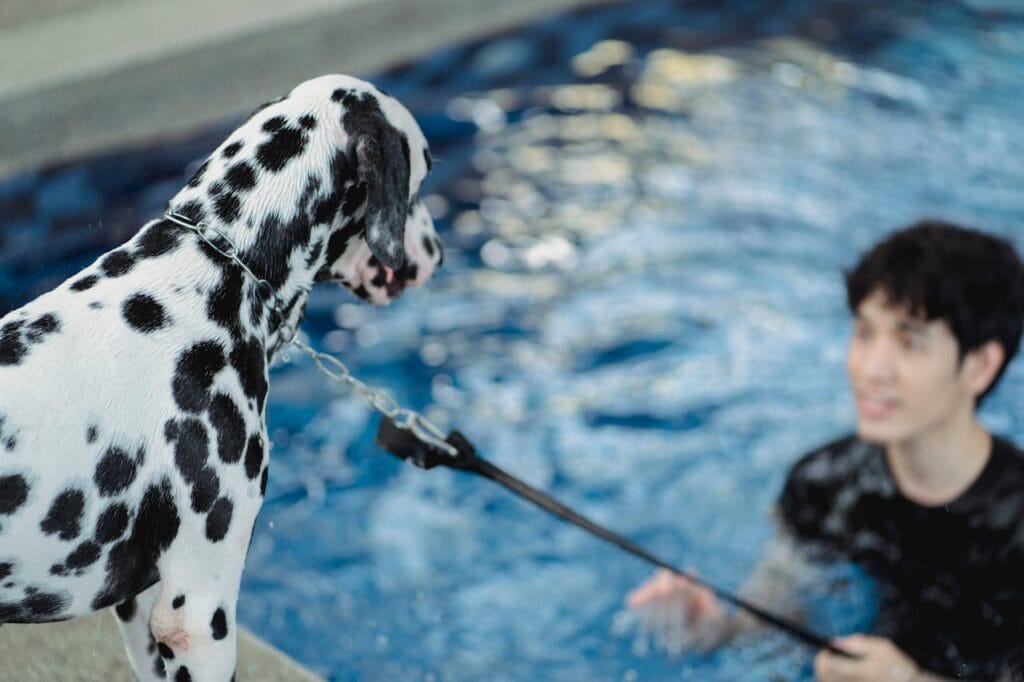Learn about Why Do Dogs Hate Baths but Love Swimming. Discover why dogs hate baths but love swimming. Learn about their sensory experiences, movement freedom, temperature differences, and how to make bath time more enjoyable.
Swimming is an activity in which the animal/human swims by synchronizing body movements. It is mainly followed as recreation, competition, or therapy. Bathing, however, consists of the actual submersion of the body into a mass of water, most commonly a bathtub, for cleansing or cleanliness reasons. Both bathing and swimming are associated with water, but swimming is mostly regarded as enjoyable, while bathing is deemed quite restrictive, particularly for animals like dogs.
Why Do Dogs Hate Baths but Love Swimming?
Reasons Why Dogs Hate Baths but Love Swimming
1. Different Sensory Experience
Different sensory factors affect how dogs view baths and swimming. A bath involves standing in a tiny space while water is poured over them, which can be an overwhelming experience. Swimming gives them a more natural and free-moving experience, which they enjoy all the more.
2. Forced vs. Voluntary Activity
Bathing most often feels restraining and uncomfortable to the dog. Bathing can, e rather stressful-forcing the dog into a tub, the slippery ceramic floor present for his convenience, or pouring a shower on him. Swimming, on the contrary, is usually a dog-initiated desire for coming and going as he pleases. In many instances, the feeling is far better.

3. Negative Past Experiences
Most dogs view anything occurring inside a bathtub as negative; slipping on the surface, water shocking in their eyes, or getting weeded shampoo used. It is really surprising how such experiences affect the next bath: they successfully resist it. In contrast, swimming is a positive experience for them: plenty of room, games, running, and water at their own pace.
4. Unfamiliar Scents and Sensations
Bath products used in washing the dog will leave traces of an odd scent, which could potentially interfere with the dog’s natural smell. A covered nose might well be an unsettling experience for any dog. Swimming could save the day; it uses no products; hence, no alterations to their scent.
5. Restricted Movement in Bathtubs
Vets say that confined spaces – tubs or bathtubs – restrict normal dog movement; they feel insecure, and this, to put it bluntly, is bad. Swimming areas are usually pretty much free; this essentially comforts and entertains your pooch, sort of giving it the freedom to be a dog.
6. Temperature Differences
Bathwater may be warm and comfortable for some dogs, but not all prefer that temperature. Others like it cold, as provided by natural bodies of water. Lakes and pools are surprisingly beneficial on a hot day for your dog’s thermoregulation; they cool off after the swim. That makes it a real treat compared to a bath!
How to Make Baths More Enjoyable for Dogs
If your dog dislikes baths but loves swimming, there are ways to make bath time more pleasant:
- Use lukewarm water to ensure comfort.
- Add positive reinforcement, such as praise and treats.
- Do not let water get in their ears and face, which can be alarming.
- Provide a non-slip mat to avoid slipping and offer a sense of stability.
- Use playtime for the bath by adding toys and interactive play.
The Psychological Difference Between Bathing and Swimming
Lack of Control in a Bath
Routine and control of their surroundings make dogs feel safe. Put in a bathtub, though, they tend to feel trapped and dreadfully helpless. They feel insecure inside the closed area and perhaps even fear falling on the slippery surface while being handled.
Swimming, on the other hand, allows free movement for dogs. They can choose whether to paddle or to play with the water. That will be the reason swimming, unlike a bath, is so enjoyable: the freedom of choice.
Negative Associations with Baths
If a dog has ever had a bad bathing experience, such as getting sprayed with very cold water, slipping, or having soap get into its eyes, that will create a negative imprint associated with a bath for life. Dogs have mighty memories, and one traumatizing bath can ruin the atmosphere for eternity.
Swimming typically denotes time for play, fun, and adventure, which fosters the positive emotional reaction opposite to that associated with a bad bath.
Pros and Cons of Swimming vs. Bathing
Swimming
Pros:
- It is one robust exercise that helps in developing bulk and strength along with stamina, improving the general condition and cardiovascular health for dogs of all ages.
- Gives stimulation and fun, in which dogs can perform their instincts like paddling and retrieving.
- Cools dogs during hot weather, keeping them from overheating and providing a refreshing and fun activity.
- Reducing bone and muscle damages by presenting an effective low-impact movement option is really the key for the dog that experiences joint pain or arthritis.
Cons:
- Diseases and infections in dogs can arise if the lakes, rivers, or swimming pools have been infected by different harmful pathogens, like parasites and bacteria.
- The lake may be poisoned by these chemicals, like chlorine, or due to an algal bloom; thus, drinking will result in toxic responses or skin irritation.
- Inadequate drying of wet fur often leads to the development of skin infections, whereby hot spots or growths of fungi occur.
Bathing
Pros:
- This enables the dog to enjoy cleanliness without dirt, fleas, or allergens, which also helps with proper hygiene for minimizing skin infection chances.
- Some odors are impossible to wash off with even the best natural water sources. The dog, therefore, ends up smelling fresh and comfy.
- Allows for deep washing, controlled and directed, so every area in the dog’s coat gets a good wash-down.
Cons:
- The bathing process can be stressful, causing anxiousness in dogs, particularly when water is a cause of fear, or when it feels restricted in a tub.
- Certain shampoos dry and irritate the skin because they strip it of all its natural oils, so only gentle products that are dog-safe should be used.
- Most dogs make a run for it when it is bath time, making it a challenge that calls for oodles of patience and nice distraction treats so that bathing can be an enjoyable experience.

FAQs
Is it okay to let my dog swim in any water body?
The fact is that all water sources are not safe; avoid swampy pools, ponds full of algae, and chemically treated pools that do not have a proper rinsing afterward to prevent infections or toxic exposure.
How can I make baths more enjoyable for my dog?
Gently use lukewarm water and shampoo. Encourage your pet by giving rewards such as treats. This essentially creates an environment that lessens tension and culminates in a delightful bathing experience.
Can all dogs swim naturally?
Some breeds are natural swimmers, for instance, those with a body structure that operates against them, for instance, Bulldogs and Pugs, while those require a little supervision around the water.
Conclusion
Swimming for dogs is about liberation and play; it offers a natural sensory experience, while bathing signifies constraint and stress. To make bathing less unpleasant for the dog, owners should appreciate this difference and apply positive reinforcement with warm water and a stress-free environment to make it pleasant for all involved.
